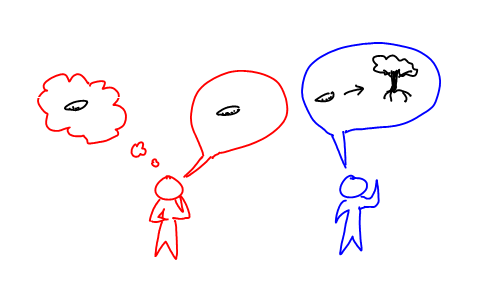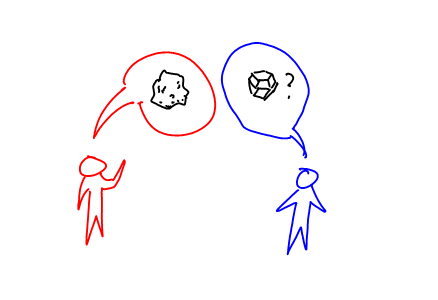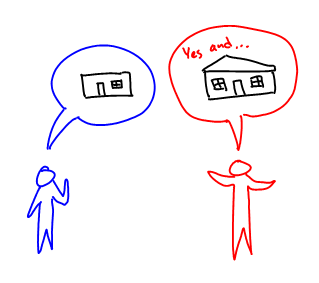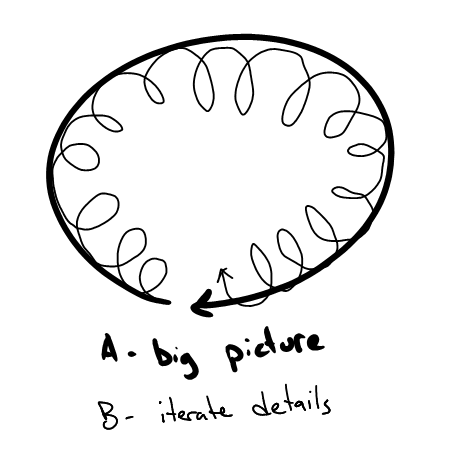Together more fun. How to establish effective cooperation of creative people
I present to you the translation of an article entitled " Better together; the practice of successful creative collaboration " by Stefan Klocek . Translated specifically for Habrahabr users with the approval of Cooper .
A rock star and a brilliant scientist are necessarily loners. That is how we used to imagine the work of a creative person. However, creative work can also flourish due to such things as differences, perseverance, exchange of ideas and cooperation.

')
Two (or more) creative people can use these virtues if they play well in a team. The “pair-design” practice used by Cooper has been growing up for more than ten years, and it develops with the growth of the company, forming new pairs in which designers learn from each other every day. Although there is no magic formula, but most of the most successful collaborative works of such a plan in our memory have surprisingly similar characteristics.
We play by the same rules.
People can cooperate with each other in a thousand different ways, but when they start playing by the same rules, they immediately notice that everything around them becomes much simpler and easier. Freedom to invent your rules on the go , according to your whim, creates a chaotic, unstable and unpredictable system. It is difficult to do your job when the basics are constantly being questioned.
Journalist David Bornstayn, who studies social innovations, described a game in a recent article for the New York Times: “The game requires mastering a complex set of skills. This is not just an opportunity to practice and let off steam. The game means that you need to agree with the same as you, enter into an imaginary structure, and accept it, even if everything goes wrong, as you would like. ”

At Cooper, we use a non-fixed set of agreements that give us the system by which we play and create together. We are all consultants involved in user-oriented design following the archetypal process (a process that is adapted to the limitations of this project), and we perform certain roles in working together. All this serves as the game rules system adopted by us.
But how to play is decided by the players themselves. We work quite independently within the spacious boundaries. Each team is free to decide how it works together and perform daily work. All this happens in an informal setting - we roughly determine the time and superficially discuss what we want to get in the end. Then we decide exactly what we have to achieve during the collaboration, as well as during the work alone.
Everyone appears at work in due time ready for work. We quickly discuss goals, allowing you to focus on important things during meetings and bring clarity to the discussion. Everyone understands each other correctly, which allows you to organize an effective discussion and postpone problems that cannot be resolved. At meetings, everyone actively contributes and moves the project forward. Playing by the rules, we relieve internal tension and feel mutual trust.
We get the most out of our differences.
We really appreciate our differences. Our idea of pair design (a pair consisting of a person who generates ideas and a person who is responsible for their synthesis) appeared when we began to notice and formalize certain differences in skills and approach to design.
A single designer is forced to do all the work himself, alternately switching between generating ideas and having to stop in order to synthesize them. In a pair, we do it simultaneously: while one designer formulates the details, the second goes in a different direction, assessing how the ideas of the first fit into the overall picture of the project. Everyone sees and promotes the same idea in his own way, which results in more efficient cooperation resulting in a more thoughtful design.
Focusing on different skills, we support and complement the partner, instead of doing the same work twice. Our method of collaboration encourages a diverse view of things, ways of thinking and knowledge.
Work and responsibilities are divided equally and fairly. It encourages differences and helps avoid unnecessary conflicts. However, this does not mean that we are afraid of conflicts. Part of the value of our differences lies in the differences that are necessarily present where there are several different points of view. Different opinions contribute to the emergence of useful questions and discussions.
From time to time we encounter significant and sometimes painful disagreements, but the tension from them acts like a hearth, helping us to separate the important from the unimportant, promising from the dead end. Complementary roles and responsibilities allow you to challenge each other’s decisions, while keeping the differences under control to achieve the best result.

When you have your own role and your responsibilities, your creativity is completely released. You no longer tread on the spot, you devote all yourselves to their specialization and expect that your partner will correct you in case of anything.
This unity of "opposites" creates productive differences and facilitates the synthesis of ideas. By hiring people, we pay special attention to their strengths and innate tendencies, and we are trying to understand whether they can fulfill one of the roles. There are no people who are ideally suited, but we believe that certain tendencies (like the tendency to think visually or in words) usually foreshadow that a person will get along in a certain role.
We do homework
In order to launch a successful product, we prepare before starting to propose solutions: we study the scope of the project, the existing problem and the users who make up the target audience. There is little sense from two poorly informed designers - by multiplying zero by something, you cannot get more.
The better prepared you are, the more confident you are to solve the problem. Creative people without the necessary knowledge of the subject have to rely only on their subjective opinion and theory. This complicates collaboration with another designer and can create unproductive conflicts between partners.
Without proper preparation, it is difficult for a team to gain momentum and enter a streaming state. The study provides the team with objective information, helping with complex systems. When both partners have all the information necessary to solve the problem, they reach the flow .
We try to ensure that both team members have a working understanding of the scope of the project and the problems we are trying to solve. If one of the team members has more experience in this field, we try to help the second one to catch up with him. Everyone needs to be familiar with the scope of the project, users that make up the target audience, and business goals in order to move smoothly and confidently to the right solutions.
We use the right tools.
If creative couples relied on subjective opinions and desires during product creation, they would simply be mired in conflicts. We get rid of most subjective opinions by using the right tools in time:
- Research instead of guesswork.
- Characters instead of personal preference.
- Scripts instead of “what if?”
- Sketches instead of working out the details (for early ideas).
- Elaboration of parts instead of sketches (in the later stages).
- Patterns instead of individual solutions.
We try not to be distracted
Too many factors distracting attention, and the main project suffers. There is a significant loss of time when switching from one project to another. Successfully working on more than one project at the same time is quite possible, but when designers work in pairs, the ability to switch between different projects does not promise anything but accumulation of unnecessary stress.

One team gets one project from us. So it is more pleasant to work, so we can better concentrate on teamwork - productivity increases, and conflicts and tensions become less. Without distractions, it's easier to concentrate. If you immerse yourself in a project entirely - success is hard not to achieve.
We do not create design alone
In many companies, working together is that one person works independently at his workplace, and then offers to evaluate the work done by another person. This approach makes your partner an editor rather than a collaborator.
For us, working together means solving big issues with a partner. It is very important that both designers feel that they work in a team. They both need to understand and improve the design of their design. Working on the project, we gradually switch between teamwork and work alone.

In the early stages of a project, we mainly work on it together. As the work on the project progresses, we spend more time alone to work out the details. When we think about the details, there are questions and problems that we did not know about before. When this happens, we get together again and solve difficult moments together. We do not make important, critical changes without a partner.
We voice our thoughts
Many designers know that if you think about everything in your head, you can find and fix all the more or less obvious flaws of the idea. However, this approach does not work in pairs - doing all the work in your head does not allow your partner to your ideas. He cannot touch them, add something or improve them.

Collective creativity makes you think out loud. By sharing raw, conceptual ideas you give your partner food for thought and inspiration. The ideas that are spoken out loud mean that the necessary information will be in the hands of the team earlier, and also make possible closer and thoughtful cooperation. This is important both during the generation of ideas, and during their study.
Both partners need to try to share quick unfiltered thoughts. It takes time to work in this way comfortably. This requires trust between partners. Trust arises in an atmosphere where one can safely share ideas and develop them. This approach to work allows you to really use the maximum efforts of two people.
Two different points of view, two minds, two creative processes, working on the right ideas, flow into faster, more complete and correct decisions.
We assume that each idea carries value, even if it does not seem so at first glance.
The first attempts to explain their idea are rarely elegant, clear and detailed. A negative reaction to a poorly expressed idea is usually perceived to be fair, but rarely helps your partner improve his idea. The fact that the first attempt to express an idea occurs with hesitation does not mean at all that the idea is bad.
Most likely, the thought of your partner is important, even if he expressed it badly. Identifying the main idea or objection of a partner always leads to a new look at what you are currently doing.

This only works if the partners have created an atmosphere in which they feel free to share ideas that have not yet been completed to form. They are trying hard to understand the design partner. When one designer suggested an idea, the second one can say what he thinks about, improve it or ask to clarify some points.
This working principle helps to get rid of self-censorship and premature correction, allowing for a deeper flow, and encouraging the exchange of ideas and trust. Nevertheless, we discard many ideas, but only after we consider them at least in a small degree.
We are building, not building up obstacles.
Shooting ideas and feedback slows down the pace of work and the favor of team members. When working together, you are considering and trying to improve what the partner suggested. You develop ideas by adding something to them, improving or clarifying for yourself the details, building your own ideas based on them.
Of course, sometimes many ideas proposed by a partner seem crazy, and discussing them seems like a waste of time. However, if you start immediately discarding the partner's offers, it is unlikely that this will advance the work, but rather stop the creative process completely.

It is also important to receive feedback. If your idea is useless, someone should tell you about it. You can not develop an idea without receiving or ignoring feedback. By fencing off partners, you do not allow them to improve your work. Negative reaction to the thrown idea does not help it to move forward.
The idea develops when you add something to it or change it in such a way that it better fits the business goals or goals of users. Then the work goes forward and everyone feels that they are on the same team.
Sometimes we understand that we can not come to an agreement, and then we accept that in this situation there is no solution that would satisfy everyone. In this case, we will take a cautious decision in any direction, remain unbiased to this decision, and move on to another task.
Sometimes the work on the rest of the system adds clarity. We will be able to come to an agreement later, when we see how other problems are solved.
We strive for progress, not perfection.
As a design consulting company, we work with clear graphics under high expectations. We try to do the work of the best possible quality in the allotted time. We strive for cool ideas, but they do not always appear the first time. We are moving to such ideas through a system of fast iterations. You can spend a lot of time, banging your heads together against the wall, trying to produce the perfect design, and not do anything.
You must have feedback from the customer and users. When you get them, you will have to revise and recycle solutions that seemed to you “perfect” or “complete.” First, we describe the picture as a whole, making sure that the proposed system works. Then we meet with the client and deliver the idea to the user.
We find out what we thought was wrong and resign ourselves to it. We will improve the product based on feedback and working more deeply on the details and nuances in successive iterations.

We have time to think about a lot in a short period of time, because we first try to get a general idea of the product, and we think over the details later. This approach brings consistency and consistency in our design. Attempting to pursue ideal solutions not only slows down the work; if we rush for too long, the creative process loses its enthusiasm, pleasure and inspiration. When we get stuck on a problem, we set it aside and return to it later.
We leave our ego behind the door
Differences of opinion can lead to painful conflicts, in the worst cases, splitting the team, stopping work and killing enthusiasm. How do we manage to make disagreements benefit instead of harm? It’s just that in disputes we don’t try to be right, but instead we try to understand what our partner is in doubt about.
When your closest and respected colleague does not agree with what you offer, most likely you have missed something important in your idea. We look at the comments of the partner as advice and efficient proposals, and not as aggressive attacks.
This does not mean that we are just such knights on blue unicorns. Sometimes criticizing or receiving criticism is unpleasant. Even when your partner has the best intentions, it’s hard to hear that your idea doesn’t work. In order to argue with a partner about the idea in which he is one hundred percent sure, courage is needed.
We leave our ego behind the door because we are well aware that the product will be better if we find out which of our decisions were in fact wrong. We do not seek consensus, however, we understand that if our partner does not agree with us, it is better to understand his point of view. Often, new innovative solutions come out of disagreements, which none of the participants initially guessed about.
We get rid of competition within the team.
Although polarity may be useful, long-term competition with a team-mate is never useful. When the discussion of the project goes from finding the right solutions to the struggle to choose one of the competing ideas, it does not bode well. Such situations rarely lead to a better solution, but of these, someone unreasonably emerges as the winner, and someone as the loser.
We believe that competition can be reduced if all participants adhere to certain roles (for example, as in a pair consisting of a person who generates ideas and a person who is responsible for their synthesis). These roles are not given out forever as labels, it is only important that during one particular meeting both designers did not try to play the same role.

In the early stages, we try to put as many ideas on the table as possible - each one generates. Then we evaluate the results, determine the strengths and weaknesses of each idea. Then we allow the person responsible for generating ideas to lead the team. Roles may temporarily change. The goal is not to strictly follow these roles, but to eliminate unnecessary, unnecessary competition.
We say "There are no duels on the drawing board!" Or "One pen is one idea." As long as your partner uses a pen to draw an idea, you are trying to understand it and give some feedback. While the partner is evaluating your idea, give him the opportunity to understand and improve it, do not go on to anything else until he finishes and is ready to move on. If at the moment your role is to synthesize, believe that your partner is trying his best to offer worthy ideas and solutions. If the idea is promising, try to improve it further.
If the idea is bad, show your partner why, and help find the best solution. If at the moment you, on the contrary, generate ideas, rely on the fact that your partner will sift out all bad ideas. He keeps you short and sees the whole picture. You rely on each other. This is balancing, work on an equal footing. You do not give up and do not give up, you are not trying to push your decision or win over your partner. Only both can win - when they try their best, play by the rules and rely on each other for uninterrupted balance.
We limit time to disputes
Differing points of view can lead to a very good understanding of the topic. They can also lead to a large number of different ideas and incompatible solutions. We appreciate different points of view, but we know that if disagreement is not resolved for a long time, nothing good will come of it.
There are cases when two reasonable people can not agree. We have approximate time limits for making decisions. If in 15 minutes we do not agree, we call the person who is not involved in the project. We explain who our users are, what goals we are trying to achieve, and what ideas we are considering.
We are not looking for a judge, but rather a person with an unbiased opinion who can take a step back and see the circumstances of the dispute. We are looking for a point of view that would allow us not to hold on to our own idea so much and bring a fresh look at the problem, which generally excludes the conflict that started it all.
We are eager for feedback.
Unspoken objections are not the best help in creative collaboration. We strive to create a culture in which everyone can say boldly that in his opinion something will not work. In an ideal world, misunderstandings, hurt feelings and assumptions would never threaten joint creative work.
If any decision seems wrong to someone, it is very important for the team to resolve this issue. We think that working atmosphere can be improved through constructive feedback and regular self-tests.
This is difficult and may initially be inconvenient, but with experience, trust grows and interaction improves. It may not be possible to build perfect friendships (though sometimes this is possible), but the ideal working relationship is easy.
Trust takes time
Newly created teams need to make an effort to start working smoothly. A new partner comes with its own unique style, habits and features. Integration of the views, experience, skills and methods of a partner requires time and effort. At first, meetings may seem tense, and the discussion is a bit awkward. After all, while you are learning to dance, you are constantly stepping on your dance partner. To create a trusting relationship you will need time and energy, however, overcoming a difficult initial period, the interaction will become easier.
Trust comes through the realization that you play by the same rules: share ideas that you then refine, feel from your own experience the value of differing opinions, pay attention to the idea, not who proposed it, come to work on time, justify expectations and honor arrangements
We work in a complex and ambiguous creative space. Building trust ensures productive work in a chaotic environment. Trust creates an opportunity for more thoughtful cooperation, mutual understanding, respect and faith in the commitment of a partner. You look forward to a new opportunity to work shoulder to shoulder and appreciate the fact that there is always someone who will help you.
You get closer, you take a call together, and you try to make the best use of your partner’s contribution. Usually it's fun, sometimes it's hard. However, when your working relationship develops sufficiently, you will most likely never want to return to work alone.
.
PS from translators: I hope you enjoyed the article. We will be happy if you point us to errors in the translation so that we can correct them promptly. Write me in PM, please :)
Source: https://habr.com/ru/post/125570/
All Articles